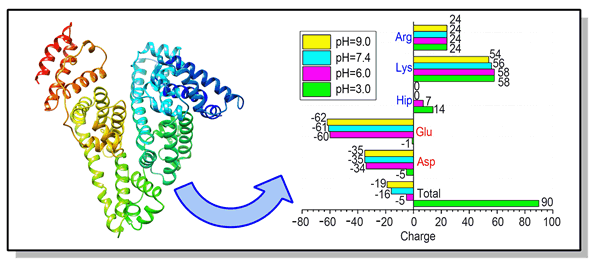| [1] Allard, J. F.; Dushek, O.; Coombs, D.; Van Der Merwe; P. A. Biophys. J. 2012, 102, 1265.
[2] Rich, R. L.; Hoth, L. R.; Geoghegan, K. F.; Brown, T. A.; LeMotte, P. K.; Simons, S. P.; Hensley, P.; Myszka, D. G. Proc. Natl. Acad. Sci. U. S. A. 2002, 99, 8562.
[3] Ballardini, R.; Balzani, V.; Credi, A.; Gandolfi, M. T.; Kotzyba-Hibert, F.; Lehn, J. M.; Prodi, L. J. Am. Chem. Soc. 1994, 116, 5741.
[4] Agasti, S. S.; Liong, M.; Tassa, C.; Chung, H. J.; Shaw, S. Y.; Lee, H.; Weissleder, R. Angew. Chem. Int. Ed. 2012, 51, 450.
[5] Gellman, S. H. Chem. Rev. 1997, 97, 1231.
[6] Berde, C. B.; Hudson, B. S.; Simoni, R. D.; Sklar, L. A. J. Biol. Chem. 1979, 254, 391.
[7] Schneider, H. J.; Yatsimirsky, A. K. Chem. Soc. Rev. 2008, 37, 263.
[8] Pal, B.; Bajpai, P. K.; Baul, T. B. Spectrochim. Acta A 2000, 56, 2453.
[9] Lyon, C. E.; Suh, E. S.; Dobson, C. M.; Hore, P. J. J. Am. Chem. Soc. 2002, 124, 13018.
[10] Cheng, L. T.; Wang, Z.; Setny, P.; Dzubiella, J.; Li, B.; McCammon, J. A. J. Chem. Phys. 2009, 131, 144102.
[11] Ma, M.; Paredes, A., Bong, D. J. Am. Chem. Soc. 2008, 130, 14456.
[12] Bader, A. N.; van Dongen, M. M.; van Lipzig, M. M.; Kool, J.; Meerman, J. H.; Ariese, F.; Gooijer, C. Chem. Res. Toxicol. 2005, 18, 1405.
[13] Colquhoun, H. M.; Zhu, Z.; Williams, D. J. Org. Lett. 2003, 5, 4353.
[14] Branco, T. J. F.; Ferreira, L. V.; do Rego, A. B.; Oliveira, A. S.; Da Silva, J. P. Photochem. Photobiol. Sci. 2006, 5, 1068.
[15] Baudry, R.; Kalchenko, O.; Dumazet-Bonnamour, I.; Vocanson, F.; Lamartine, R. J. Chromatogr. Sci. 2003, 41, 157.
[16] Xiao, Z.-Y.; Lin, R.-L.; Tao, Z.; Liu, Q.-Y.; Liu, J.-X.; Xiao, X. Org. Chem. Front. 2017, 4, 2422.
[17] Baudoin, O.; Gonnet, F.; Teulade-Fichou, M. P.; Vigneron, J. P.; Tabet, J. C., Lehn, J. M. Chem. Eur. J. 1999, 5, 2762.
[18] Kukic, P.; Nielsen; J. E. Future Med. Chem. 2010, 2, 647.
[19] Jakoby IV, M. G.; Miller, K. R.; Toner, J. J.; Bauman, A.; Cheng, L.; Li, E.; Cistola, D. P. Biochemistry 1993, 32, 872.
[20] Quan, X.; Dong, J.; Zhou, J. Acta Chim. Sinica 2014, 72, 1075. (全学波, 董佳奇, 周健, 化学学报, 2014, 72, 1075.)
[21] Li, L.; Lü, M.; Lu, K.; Liu, G.; Peng, L. Chin. J. Org. Chem. 2018, 38, 246. (李林璐, 吕名秀, 卢奎, 刘广斌, 彭露, 有机化学, 2018, 38, 246.)
[22] Linderstrøm-Lang, K. C. R. Trav. Lab. Carlsberg 1924, 15, 1.
[23] Shishkov, I. F.; Khristenko, L. V.; Rudakov, F. M.; Vilkov, L. V.; Karlov, S. S.; Zaitseva, G. S.; Samdal, S. J. Mol. Struct. 2002, 641, 199.
[24] Bhattacharya, B.; Nakka, S.; Guruprasad, L.; Samanta, A. J. Phys. Chem. B 2009, 113, 2143.
[25] Jang, H.; Hall, C. K.; Zhou, Y. Biophys. J. 2002, 83, 819.
[26] de Oliveira, C. A. F.; Guimarães, C. R. W.; Barreiro, G.; de Alencastro, R. B. Proteins 2003, 52, 483.
[27] Bolel, P.; Datta, S.; Mahapatra, N.; Halder, M. J. Phys. Chem. B 2014, 118, 26.
[28] Baler, K.; Martin, O. A.; Carignano, M. A.; Ameer, G. A.; Vila, J. A.; Szleifer, I. J. Phys. Chem. B 2014, 118, 921.
[29] Meyer, B.; Peters, T. Angew. Chem. Int. Ed. 2003, 42, 864.
[30] Karplus, M.; McCammon, J. A. Nat. Struct. Biol. 2002, 9, 646.
[31] Zhang, Y.; Wu, S.; Qin, Y.; Liu, J.; Liu, J.; Wang, Q.; Ren, F.; Zhang, H. Food Chem. 2018, 240, 1072.
[32] De Wit, C. A. Chemosphere 2002, 46, 583.
[33] Zhao, N.; Xuan, S.; Fronczek, F. R.; Smith, K. M.; Vicente, M. G. J. Org. Chem. 2017, 82, 3880.
[34] Balamurugan, R.; Stalin, A.; Ignacimuthu, S. Eur. J. Med. Chem. 2012, 47, 38.
[35] Dolinsky, T. J.; Czodrowski, P.; Li, H.; Nielsen, J. E.; Jensen, J. H.; Klebe, G.; Baker, N. A. Nucleic Acids Res. 2007, 35, 522.
[36] Li, Y.; Liu, X.; Dong, X.; Zhang, L.; Sun, Y. Langmuir 2014, 30, 8500.
[37] Aliev, A. E.; Kulke, M.; Khaneja, H. S.; Chudasama, V.; Sheppard, T. D.; Lanigan, R. M. Proteins:Structure, Function, and Bioinformatics 2014, 82, 195-215.
[38] Darden, T.; York, D.; Pedersen, L. J. Chem. Phys. 1993, 98, 10089.
[39] Ryckaert, J. P.; Ciccotti, G.; Berendsen, H. J. J. Comput. Phys. 1977, 23, 327.
[40] Sudhamalla, B.; Gokara, M.; Ahalawat, N.; Amooru, D. G.; Subramanyam, R. J. Phys. Chem. B 2010, 114, 9054.
[41] Baler, K.; Martin, O. A.; Carignano, M. A.; Ameer, G. A.; Vila, J. A.; Szleifer, I. J. Phys. Chem. B 2014, 118, 921.
[42] Jiang, Q.; Zhang, Z.; Liu, Y.; Yao, N.; Wang, J. Chin. J. Org. Chem. 2017, 37, 1814. (姜齐永, 张珠, 刘洋, 姚楠楠, 王进军, 有机化学, 2017, 37, 1814.)
[43] Lu, Z.; Qi, L.; Li, G.-X.; Li, Q.; Sun, G.-H.; Xie, R.-Z. J. Solution Chem. 2014, 43, 2010.
[44] Rehman, M. T.; Shamsi, H.; Khan, A. U. Mol. Pharm. 2014, 11, 1785.
[45] Rahman, T.; Rahmatullah, M. Bioorg. Med. Chem. Lett. 2010, 20, 537.
[46] Dong, K.; Yang, X.; Zhao, T.; Zhu, X. Mol. Simulat. 2017, 43, 599. |
